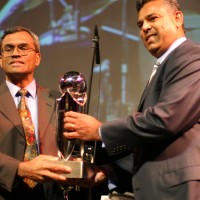Derrick Wong’s gambit is paying off. There’s no stopping the rising wave of Chinese tourists in Sri Lanka even as relations between the two nations have receded from last year’s high-water mark.
“If politics affected tourism, there wouldn’t be so many Chinese tourists in Japan,” said Derrick Wong, the owner of Grand Beijing Chinese Restaurant in Colombo 3.
In February, China quietly replaced the UK as the second-biggest source of tourists after India with an 85.6 per cent year-on-year growth, outpacing the 11.6 per cent rise in overall tourist numbers. Last month, tourist arrivals from China again jumped 81.5 per cent compared to March last year. With that, Chinese tourists in the first quarter of this year have risen 84.5 per cent, beating all other nationalities.
The trend defies the strain in bilateral relations this year since January’s presidential elections, when pro-China Mahinda Rajapaksa was ousted from power. The new government sees big-ticket infrastructure projects funded by China and executed by Chinese companies as overpriced white elephants pushed through by the previous government to line its pockets, and is reviewing many of them.
One project in particular, the US$1.4 billion Colombo Port City that was inaugurated by President Xi Jinping, has become a bone of contention since the new government halted it last month. While the government maintains the Chinese company started the project without the necessary documents, Beijing has repeatedly urged Colombo to respect contractual obligations and protect Chinese investments.
The surge in the number of Chinese visitors is particularly stunning given that it was just 54,288 in 2013. By the end of 2014, that number rose more than 136 per cent to 128,166, according to the Sri Lanka Tourism Development Authority, which is hoping to leverage Chinese tourists to attract 2.5 million visitors by 2016, compared with 1.5 million last year.
With an estimated 174 million Chinese tourists tipped to spend US$264 billion by 2019, Sri Lanka has been quick to spot an opportunity.
Sri Lanka Tourism Promotion Bureau chairman Rohantha Athukorala told the South China Morning Post: “We ran branding campaigns in key Chinese cities on buses and taxis. We invited over 300 travel agents and 150 journalists to Sri Lanka. We have also run advertising campaigns, taken part in the key exhibitions in each province, and conducted road shows across China to promote Sri Lanka as a tourist destination.”
Tourism plays a major role in the US$67 billion economy of this tropical paradise.
“While tourism is directly a US$1.7 billion revenue earner, if we take the total value chain, it is a US$6-7 billion dollar industry and the No 1 foreign exchange earner,” said Athukorala, who launched yet another program this week to target the Chinese market through WeChat and Weibo.
Like Athukorala, the 30-year-old Wong spotted the trend of Chinese tourists early on and quit his Huawei job in Colombo to set up the restaurant six months ago. He is upbeat on the resurgence of Sri Lankan consumer spending since the end of the war in 2009, but what he is really angling for is Chinese tourists.
That is why he is serving up authentic Chinese food, breaking with the tradition of “currified” Chinese fare common in South Asia that Chinese immigrants generations before him developed to popularize their cuisine.
“Generally, Sri Lankan and Chinese guests at my restaurant are split almost 50-50. But on days I get tour operators bringing in tourists, the Chinese account for nearly 70 per cent of my clientele,” said Wong.
Hundreds of small Chinese entrepreneurs like Wong, away from the spotlight on Chinese infrastructure companies pumping billions of dollars into Sri Lanka, have in the past two years set up hotels, travel agencies and restaurants in anticipation of the coming wave. The bigger fish are also repositioning themselves.
“We are going all out to tap the potential of the growing Chinese tourism market,” said Cinnamon Hotels and Resorts city sector head Rohan Karr.
Xi Jinping and first lady Peng Liyuan stayed at the group’s Cinnamon Grand Colombo on their trip to the island in September.
“We are aware of the distinct requests of Chinese travellers and are looking at products and services geared towards them, breaking language barriers and offering unique experiences,” said Karr.
The three city hotels in the Cinnamon group are recruiting personnel fluent in Mandarin while front-line staff are being taught basic Mandarin. They are also preparing to dedicate two floors in each of the hotels to Chinese guests and overhaul the menu.
Shangri-la has jumped into the fray as well. It is building a mixed-use development of a 500-room hotel, luxury apartments, offices and retail space in Colombo’s prime One Galle Face area overlooking the Indian Ocean, and a resort in Hambantota in the south. The 300-room resort is due to open late this year and the hotel in 2017.
“The increase in Chinese arrivals presents a wonderful opportunity. With our 30-year history of operating hotels in mainland China, the Chinese traveller is very familiar with Shangri-La,” said Lori Lincoln, director of corporate communications at Shangri-La International Hotel Management.
Shangri-La is part of the Kerry Group, the controlling shareholder of SCMP Group which publishes the South China Morning Post.
Courtesy: South China Morning Post










![TV-Poster-All-Exhibition-Sri-Lanka-in-Focus-USA-2025[1]](https://www.srilankafoundation.org/wp-content/uploads/2025/04/TV-Poster-All-Exhibition-Sri-Lanka-in-Focus-USA-20251-450x450.jpg)











